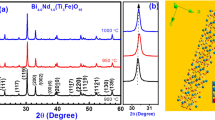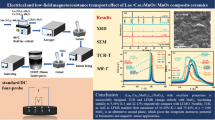Abstract
The assertion that a new material could become a potential single-phase and room-temperature functioning multiferroic material may be confounded by the presence of minor amount of secondary magnetic inclusions, especially in the Aurivilliustype material system. In this study, we demonstrated that the derivative thermo-magneto-gravimetry (DTMG) technique can be a sensitive tool to identify an d quantify the magnetic secondary phases in the Bi7Fe2.25Co0.75Ti3O21 ceramic, which shows the potential to become a single-phase multiferroic material. The accuracy of this DTMG measurement experimentally reaches to ~0.5 wt.%, far below the detection limit of the traditional X-ray diffraction. The impurity identified in the specimen is the ferrimagnetic CoFe2O4 spinel phase with an amount of ~3.6 wt.%. Significantly, the room-temperature intrinsic magnetism of the ceramic was measured, which is sorely from the main phase.
中文摘要
判断新的材料是否是一个室温单相多铁性材料需要认真的鉴定评价, 特别是对于Aurivillius 相多铁材料. 这类材料中易生 成微量的具有铁磁性的杂质, 从而混淆对其本征磁性能的判断. 本论文介绍了一种磁失重方法, 并应用该方法判断和量化了Aurivillius 相层状结构陶瓷Bi7Fe2.25Co0.75Ti3O21中的磁性杂质. 该方法的测量精度远高于X-射线仪器的精度, 能够辨别出含量仅为0.5%重量的杂质. 最终结果表明陶瓷B i7Fe2.25Co0.75Ti3O21中的磁性杂质是尖晶石相CoFe2O4, 其含量约占总质量的3.6%. 通过该方法同时确定了该陶瓷的室 温固有磁性. 本研究不仅展示了磁失重方法, 而且通过固有磁性和固有铁电性的鉴定, 证明了该陶瓷是一种新的室温单相多铁性材料.
Similar content being viewed by others
References
Spaldin NA, Cheong SW, Ramesh R. Multiferroics: past, present, and future. Phys Today, 2010, 63: 38–43
Hill NA. Why are there so few magnetic ferroelectrics? J Phys Chem B, 2000, 104: 6694–6709
Eerenstein W, Mathur ND, Scott JF. Multiferroic and magnetoelectric materials. Nature, 2006, 442: 759–765
Krzhizhanovskaya M, Filatov S, Gusarov V, et al. Aurivillius phases in the Bi4Ti3O12/BiFeO3 system: thermal behaviour and crystal structure. Z Anorg Allge Chem, 2005, 631: 1603–1608
Zhao H, Kimura H, Cheng Z. et al. Large magnetoelectric coupling in magnetically short-range ordered Bi5Ti3FeO15 film. Sci Rep, 2014, 4: 5255
Li XN, Ju Z, Li F, et al. Visible light responsive Bi7Fe3Ti3O21 nanoshelf photocatalysts with ferroelectricity and ferromagnetism. J Mater Chem A, 2014, 2: 13366–13372
Wang JL, Fu ZP, Peng RR, et al. Low magnetic field response single- phase multiferroics under high temperature. Mater Horiz, 2015, 2: 232–236
Yuan B, Yang J, Chen J, et al. Magnetic and dielectric properties of Aurivillius phase Bi6Fe2Ti3−2x NbxCoxO18 (0 ≤ x ≤ 0.4). Appl Phys Lett, 2014, 104: 062413
Sun SJ, Wang GP, Huang Y, et al. Structural transformation and multiferroic properties in Gd-doped Bi7Fe3Ti3O21 ceramics. RSC Adv, 2014, 4: 30440–30446
Mao XY, Sun H, Wang W, et al. Ferromagnetic, ferroelectric properties, and magneto-dielectric effect of Bi4.25La0.75Fe0.5Co0.5Ti3O15 ceramics. Appl Phys Lett, 2013, 102: 072904
Mao XY, Wang W, Chen XB, et al. Multiferroic properties of layer- structured Bi5Fe0.5Co0.5Ti3O15 ceramics. Appl Phys Lett, 2009, 95: 082901
Schmidt M, Amann A, Keeney L, et al. Absence of evidence not equal evidence of absence: statistical analysis of inclusions in multiferroic thin films. Sci Rep, 2014, 4: 5712
Palizdar M, Comyn TP, Ward MB, et al. Crystallographic and magnetic identification of secondary phase in orientated Bi5Fe0.5Co0.5Ti3O15 ceramics. J Appl Phys, 2012, 112: 073919
Williams DB, Papworth AJ, Watanabe M. High resolution X-ray m apping in the STEM. J Electron Microsc, 2002, 51: S113–S126
Moskalewicz R, Zych W. Application of the DTMG-DTA(M) technique for the curie-point and crystallization temperature determinature of Fe80−x MnxB20 amorphous-alloys. Phys Status Solidi A-Appl Res, 1986, 97: K43–K48
Li XN, Zhu Z, Feng L, et al. Facile route to prepare grain-oriented multiferroic Bi7Fe3−x CoxTi3O21 ceramics. J Eur Ceram Soc, 2015, 35: 3437–3443
Keeney L, Kulkarni S, Deepak N, et al. Room temperature ferroelectric and magnetic investigations and detailed phase analysis of Aurivillius phase Bi5Ti3Fe0.7Co0.3O15 thin films. J Appl Phys, 2012, 112: 024101
Srinivas A, Kumar MM, Suryanarayana SV. Investigation of dielectric and magnetic nature of Bi7Fe3Ti3O21. Mater Res Bull,1999, 34: 989–996
Lu SZ, Qi XD. Magnetic and dielectric properties of nanostructured BiFeO3 prepared by sol–gel method. J Am Ceram Soc, 2014, 97: 2185–2194
Zi Z, Sun Y, Zhu Y, et al. Synthesis and magnetic properties of CoFe2O4 ferrite nanoparticles. J Magn Magn Mater, 2009, 321: 1251–1255
Nlebedim IC, Snyder JE, Moses AJ, et al. Effect of deviation from stoichiometric composition on structural and magnetic properties of cobalt ferrite, CoxFe3−x O4 (x = 0.2 to 1.0). J Appl Phys, 2012, 111: 07D704
Suzuki T, Nagai H, Nohara M, et al. Melting of antiferromagnetic ordering in spinel oxide CoAl2O4. J Phys Conden Matter, 2007, 19: 145265
Grave ED, Persoons R, Vandenberghe R, et al. Mössbauer study of the high-temperature phase of Co-substituted magnetites, CoxFe3−x O4. Phys Rev B, 1993, 47: 5881–5893
Fujii T, de Groot FMF, Sawatzky GA. In situ XPS analysis of various iron oxide films grown by NO2-assisted molecular-beam epitaxy. Phys Rev B, 1999, 59: 3195–3202
Mitra S, Das S, Mandal K, et al. Synthesis of a α-Fe2O3 nanocrystal in its different morphological attributes: growth mechanism, optical and magnetic properties. Nanotechnology, 2007, 18: 275608
Muralidharan R, Dix D, Skumryev V, et al. Synthesis, structure, and magnetic studies on self-assembled BiFeO3-CoFe2O4 nanocomposite thin films. J Appl Phys, 2008, 103: 07E301
Zheng H, Wang J, Mohaddes-Ardabili L, et al. Three-dimensional heteroepitaxy in self-assembled BaTiO3-CoFe2O4 nanostructures. Appl Phys Lett, 2004, 85: 2035–2037
Li J, Levin I, Slutsker J, et al. Self-assembled multiferroic nanostructures in the CoFe2O4-PbTiO3 system. Appl Phys Lett, 2005, 87: 072909
Mao XY, He JH, Zhu J, et al. Structural, ferroelectric, and dielectric properties of vanadium-doped Bi4−x/3Ti3−x VxO12. J Appl Phys, 2006, 100: 044104
Hu GD, Cheng X, Wu WB, et al. Effects of Gd substitution on structure and ferroelectric properties of BiFeO3 thin films prepared using metal organic decomposition. Appl Phys Lett, 2007, 91: 232909
Author information
Authors and Affiliations
Corresponding authors
Additional information
Shujie Sun is currently a PhD candidate of materials science at the Department of Materials Science and Engineering, University of Science and Technology of China (USTC), Hefei, China. His scientific interests are mainly focused on the structure and properties of complex oxides materials.
Yalin Lu is a full professor of the USTC. He is now Director of National Synchrotron Radiation Laboratory, Deputy Director of Hefei Science Center. Before joining the USTC, he was a visiting professor at Lawrence Berkeley National Laboratory (1996–1998), a research professor in electrical engineering at Tufts University (1998–2000) and a full professor in physics at the US Air Force Academy (2003–2012). His research group in the USTC works on materials for energy conversion, THz optics and materials, optoelectronics, and complex oxides materials physics.
Rights and permissions
About this article
Cite this article
Sun, S., Liu, C., Peng, R. et al. Measuring room-temperature intrinsic multiferroic properties by excluding the secondary magnetic inclusion contribution. Sci. China Mater. 58, 791–798 (2015). https://doi.org/10.1007/s40843-015-0087-5
Received:
Accepted:
Published:
Issue Date:
DOI: https://doi.org/10.1007/s40843-015-0087-5




